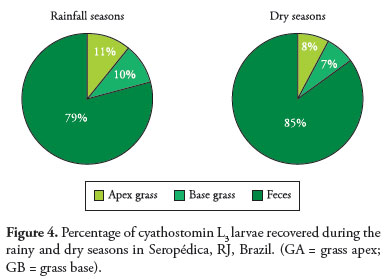The presence of cyathostomin larvae is directly associated to climatic conditions of each region. This study aimed to evaluate the ecology of infective larvae on Brachiaria humidicola during the dry and rainy seasons from October 2007 to September 2008 in a tropical region, Rio de Janeiro state, southeastern Brazil. Stools were collected from the rectum of horses naturally infected with cyathostomins at the beginning of the rainy season (October to March) and dry season (April to September). They were divided into four samples of 500 g and deposited on a grass patch of B. humidicola. Seven days later and every 15 days thereafter samples of feces and grass were collected and processed by the Baermann technique. The mean number of larvae recovered from the grass varied according to the season, with greater recovery of larvae during the peak of the dry season (14,700 L3.kg-¹ DM). There was a statistically significant difference between L3 recovered from feces and grass, but not between L3 recovered from the grass base and apex. These results show that the region’s climate favors the development and survival of infective cyathostomin larvae throughout the year, with a greater number of larvae during the dry season.
Infective larvae; wet and dry seasons; Brachiaria humidicola; cyathostomin




